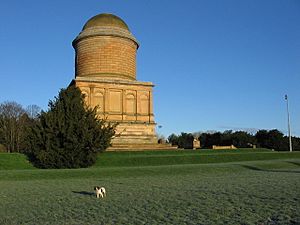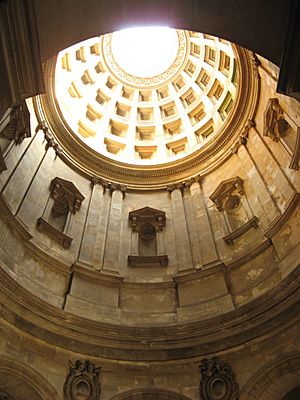Hamilton Mausoleum facts for kids

Hamilton Mausoleum
|
|
| Location | Hamilton, South Lanarkshire, Scotland |
|---|---|
| Designer | David Hamilton David Bryce |
| Material | sandstone, marble, bronze |
| Height | 37.6 m (123 ft) |
| Beginning date | 1842 |
| Completion date | 1858 |
The Hamilton Mausoleum is a special building located in Hamilton, South Lanarkshire, Scotland. It was once the burial place for the important family of the Dukes of Hamilton.
This amazing building used to hold the world record for the longest echo inside any man-made structure! If you slammed a door inside, the sound would take 15 seconds to fade away. In 2014, this record was broken by the Inchindown oil storage tanks in the Scottish Highlands. The mausoleum stands in the area where the grand Hamilton Palace once stood, which has now been taken down.
Contents
Building the Mausoleum
Why it was Built
The 10th Duke of Hamilton, named Alexander, wanted a new and impressive place for his family to be buried. He decided to replace their old burial vault, which was in a worn-out church near his home, Hamilton Palace.
Construction Details
Work on the Hamilton Mausoleum began in 1842. The main architect was David Hamilton. Later, David Bryce and sculptor Alexander Handyside Ritchie helped finish the building in 1858. This was five years after the 10th Duke had passed away.
The mausoleum is built in a Roman style. It has a large dome and is made of stone blocks. It stands very tall, about 123 feet (37.6 meters) high. It's located about 650 feet (198 meters) north of where Hamilton Palace used to be. Today, it's one of the few things left that shows how huge and grand the buildings in Hamilton Low Parks once were.
Original Burials and Relocation
The 10th Duke was buried in the main chapel of the mausoleum. His coffin was an ancient Egyptian sarcophagus from the Ptolemaic period. Seventeen of his family members were buried in a special room called a crypt below the main chapel.
However, over time, the ground around the mausoleum started to sink. This was due to subsidence and flooding from the nearby River Clyde. Because of these problems, the family decided to move the remains of their ancestors. In 1921, most of the family members were re-buried in Hamilton's Bent Cemetery. The 11th and 12th Dukes were moved to the Isle of Arran.
Life of the Mausoleum
The Building's Lean
In the 1960s and 1970s, people noticed that the mausoleum was leaning. A special weight hanging from the front showed it was about 20 feet (6 meters) off true vertical! Luckily, the way the building was made, with a strong base, stopped it from cracking. After many years, the building slowly settled back to almost straight up again.
Amazing Acoustics
Inside the mausoleum, you can see the original bronze entrance doors. These doors were inspired by the famous doors of the Florence Baptistery in Italy. When these heavy doors are slammed shut, they create one of the longest-lasting echoes in the world! This is often shown to visitors.
Another cool feature inside is the "Whispering Walls." If two people stand at opposite ends of one of the curved inner walls, facing away from each other, they can whisper. The amazing way the walls are shaped makes the sound travel, so the other person can hear the whisper clearly!
Dome Replacement
In 1971, the glass window (called an oculus) in the dome at the top of the mausoleum was replaced. A new, clear plastic version was put in place. It was so big that a helicopter had to be used to lift it into position!
Images for kids
See also
 In Spanish: Mausoleo Hamilton para niños
In Spanish: Mausoleo Hamilton para niños



